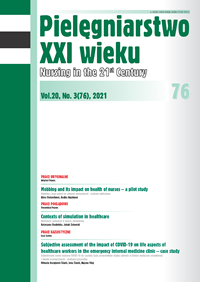Mobbing and its impact on health of nurses – a pilot study
DOI:
https://doi.org/10.2478/pielxxiw-2021-0022Keywords:
GHQ-28, impacts on health, mobbing, NAQ-R, nursesAbstract
MOBBING AND ITS IMPACT ON HEALTH OF NURSES – A PILOT STUDY
Aim. The aim of this study was to determine the occurrence of mobbing and its health impacts on nurses in the selected hospital.
Method. The pilot study was performed from August to September 2020. The group consisted of 84 nurses (return was 56.0%), working in the acute care department in a selected medical facility. NAQ-R (Negative Acts Questionnaire-Revised) and GHQ-28 (General Health Questionnaire-28) tools were used.
Results. In total 10.50% of nurses experienced mobbing. Mobbing was targeted at the work-oriented and nurse-related areas. The most common descriptive phenomenon of mobbing is the assignment of tasks below the level of competencies. Nurses describing the occurrence of mobbing in the workplace more often reported feelings of constant tension, nervousness and pressure.
Conclusions. The occurrence of mobbing in the workplace can affect the health and cause mental and social problems of nurses.
References
1. Leymann H. The content and development of mobbing at work. European Journal of Work and Organizational Psychology. 1996; 5(2), 165-184. https://www.tandfonline.com/doi/abs/10.1080/13594329608414853
2. Fugueiredo-Ferraz H, Gill-Monte PR, Olivares-Faúndez VE. Influence of mobbing (workplace bullying) on depressive symptoms: a longitudinal study among emloyees working with people with intellectual disabilities. Journal of Intellectual Disability Research. 2015; 59(1), 39-47. https://onlinelibrary.wiley.com/doi/epdf/10.1111/jir.12084/.
3. Berry PA, Gillespie GL, Gates D, Schafer J. Novice nurse productivity following workplace bullying. Journal of Nursing Scholarship. 2012; 44(1), 80-87. https://doi.org/101111/j.1547-5069.2011.01436.x.
4. Somani R, Karmaliani R, Mc Farlene J, et al. Prevalence of Mobbing/Bullying behaviour among Nurses of Private and Public Hospitals in Karachi, Pakistan. International Journal of Nursing Education. 2015; 8(2), 235-239.
5. Turan N, Öncü B. Psychological Violence in the Workplace (Mobbing): Investigation of the Relationship Between Personal Characteristics and Workload. Turkiye Klinikleri Journal of Nursing Sciences. 2018; 10(2), 92-102. https://doi.org/10-5336/nurses.2017-57555.
6. Babiarczyk B, Turbiarz A, Tomagová M, et al. Violence against nurses working in the health sector in five European countries - pilot study. Int. J. Nurs. Pract. 2019; e12744. https://doi.org/10.1111/ijn.12744.
7. Myers G, Cote-Arsenault D, Worral P, et al. A cross-hospital exploration of nurses´experiences with horizontal violence. Journal of Nursing Management. 2016; 24, 624-633. https://doi.org/10.1111/jonm.12365.
8. Difazio RL, Vessey JA, Buchko OA, et al. The incidence and outcomes of nurse bullying in the Russian Federation. International Nursing Review; 66: 94-103. https://doi.org/10.1111/inr.12479.
9. Rasool SM, Wang M, Zhang Y, et al. Sustainble work performance: The roles of workplace violence and occupational Stress. International Journal of Enviromental Research and Public Health. 2020; 17, 912-924. https://www.mdpi.com/1660-4601/17/3/912.
10. Giorgi, G, Manusco S, Fiz Perez F, et al. Bullying among nurses and its relationship with burnout and organizational climate. International Journal of Nursing Practice. 2016; 22: 160-168. https://doi.org/10.1111/ijn.12376.
11. Rayan A, Sisan M, Baker O. Stress, workplace violence and Burnout in nurses working in King Abdullah Medical city during Al-Hajj Season. The Journal of Nursing Research. 2019; 27(3): e26.
12. Chatziioannidis I, Bascilla FG, Chatzivalsama P, et al. Prevalence, causes and mental health impact of workplace bullying in the Neonatal Intensive Unit Care environment. BMJ Open. 2018; 8: e018766. https://bmjopen.bmj.com/content/8/2/e018766.
13. Durmus SC, Topcu I, Yildirim A. Mobbing Behaviors Encountered by Nurses and their Effects on Nurses. International Journal of Caring Sciences. 2019; 11(2), 905-915. http://internationaljournalofcaringsciences.org/docs/32_durmus_original_10_2.pdf.
14. Tong M, Schwendimann R, Zuñíga F. Mobbing among care workers in nursing homes: A cross-sectional secondary analysis of the Swiss Nursing Homes Human Resources Project. International Journal Journal of Nursing Studies. 2017; 66, 72-81. https://doi.org/10.1016/j.ijnurstu.2016.12.005
15. Sperry L, Duffy M. Workplace Mobbing: Family dynamics and Therapeutic Considerations. The American Journal of Family Therapy. 2009; 37(5), 433-442. https://www.tandfonline.com/doi/abs/10.1111/nhs.12297.
16. Al-Sagarat A, Qan´ir Y, Al-Azzam M, et al. Assessing the impact of workplace bullying on nursing competences among registered nurses. Jordanian Nursing and Health Sciences. 2016; 18(2), 172-179. https://doi.org/10.1111/nuf.12253.
17. Carter M, Thompson M, Crampton P, et al. Workplace bullying in the UK NHS: a questionnaire and interview study on prevalence, impact and barriers to reporting. BMJ Open. 2013; 3: e002628. http://dx.doi.org./10.1136/bmjopen-2013-002628.
18. Kozáková R, Bužgová R, Zeleníková R. Mobbing of nurses: Prevalence, forms and psychological consequences in the Moravian-Silesian region. Ceskoslovenska psyhologie. 2018; 62(4), 316-329. ISSN 0009-062X.
19. Pasek M, Skrzeczyńska J, Dębska G, et al. Mobbing: Violence at work or semantic abuse – the evaluation of the phenomenon by professionally active nurses. Nursing problems. 2020; 28(2), 80-87. https://doi.org/10.5114/ppiel.2020.98768.
Downloads
Published
Issue
Section
License
Copyright (c) 2021 Authors

This work is licensed under a Creative Commons Attribution-NonCommercial-NoDerivatives 4.0 International License.




